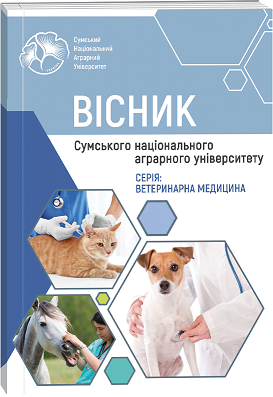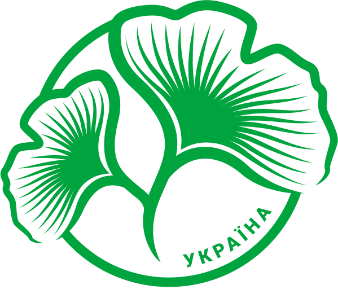LEPTOSPIROSIS OF FARM ANIMALS IN THE SUMY REGION
Abstract
Leptospirosis is a dangerous zoonotic disease, the monitoring of which is necessary not only for the stable functioning of agricultural enterprises, but also for the protection of human health. The purpose of this work was to analyse the results of the monitoring research among livestock species in the Sumy region for the period 2021-2024 and to take into account factors that may affect the results of monitoring and the intensity of the disease spread. As a result of the analysis, it was found that the epizootic situation shows a positive trend, which is reflected in the decrease of the disease rate among the tested farm animals. No cases of leptospirosis have been detected in sheep and goats over the last four years, but in cattle tested, the disease rate was 19.5% at the beginning of the period analysed (2021) and gradually decreased to 9% in October 2024. There is also a positive trend for pigs, although there was a 50% increase in the number of sick animals in 2023 compared to 2022. The percentage of positively reacting animals among the tested horses has fluctuated significantly, dropping to 1.6% in 2022 and remaining at 9%-11% for the last two years (2023–2024). The next step was to analyse changes in the number of livestock animals on the territory of the Sumy region, as the number of susceptible animals has a direct impact on the intensity of the spread of the disease. Analysis of the reports of the State Statistics Service of Ukraine showed that the improvement in the situation could be due to a significant reduction in the number of livestock animals and a decrease in monitoring coverage, which could give a false picture of the epizootic situation of leptospirosis. Particular attention was also paid to the analysis of factors that might influence the spread of leptospirosis in the context of military activities and lead to a deterioration of the epizootic situation on the territory of the region. The main risk factors identified were water pollution, rodent population growth and socio-economic changes. In 2024, the Sumy region is still not really safe for leptospirosis, which indicates the need for continuous monitoring of the disease in livestock species and pets, strengthening of preventive measures, monitoring of the sanitary condition of water bodies, improving water quality and implementation of regular deratisation activities.
References
2. Calderón, A., Rodríguez, V., Máttar, S., & Arrieta, G. (2014). Leptospirosis in pigs, dogs, rodents, humans, and water in an area of the Colombian tropics. Tropical animal health and production, 46(2), 427–432. https://doi.org/10.1007/s11250-013-0508-y
3. Di Azevedo, M. I. N., & Lilenbaum, W. (2021). An overview on the molecular diagnosis of animal leptospirosis. Letters in applied microbiology, 72(5), 496–508. https://doi.org/10.1111/lam.13442
4. Díaz, E. A., Arroyo, G., Sáenz, C., Mena, L., & Barragán, V. (2023). Leptospirosis in horses: Sentinels for a neglected zoonosis? A systematic review. Veterinary world, 16(10), 2110–2119. https://doi.org/10.14202/vetworld.2023.2110-2119
5. Dubey, S., Singh, R., Gupta, B., Patel, R.P., Soni, D., Dhakad, B.K., Reddy, B.M., Gupta, S., & Sharma, N. (2021). Leptospira: An emerging zoonotic pathogen of climate change, global warming and unplanned urbanization: A review. Journal of Entomology and Zoology Studies 9.1, pp. 564–571.
6. Ellis W. A. (2015). Animal leptospirosis. Current topics in microbiology and immunology, 387, 99–137. https://doi.org/10.1007/978-3-662-45059-8_6
7. Flay, K. J., Yang, D. A., Wilson, M. T., Lee, S. H., Bhardwaj, V., Hill, F. I., & Pfeiffer, D. U. (2021). Absence of serological or molecular evidence of Leptospira infection in farmed swine in the Hong Kong Special Administrative Region. One health (Amsterdam, Netherlands), 13, 100321. https://doi.org/10.1016/j.onehlt.2021.100321
8. Flores, B., Escobar, K., Muzquiz, J. L., Sheleby-Elías, J., Mora, B., Roque, E., Torres, D., Chávez, Á., & Jirón, W. (2020). Detection of Pathogenic Leptospires in Water and Soil in Areas Endemic to Leptospirosis in Nicaragua. Tropical medicine and infectious disease, 5(3), 149. https://doi.org/10.3390/tropicalmed5030149
9. Goarant C, Trueba G, Bierque E, Thibeaux R, Davis B, De la Peña Moctezuma (2019). Leptospira and leptospirosis. In: Rose JB, JiménezCisneros B, editors. Water and sanitation for the 21st century: health and microbiological aspects of excreta and wastewater management (Global Water Pathogen Project). (Pruden A, Ashbolt N, Miller J, editors. Part 3: Bacteria.) East Lansing, Michigan: Michigan State University Press, UNESCO.
10. Goris, M. G., & Hartskeerl, R. A. (2014). Leptospirosis serodiagnosis by the microscopic agglutination test. Current protocols in microbiology, 32, . https://doi.org/10.1002/9780471729259.mc12e05s32
11. Hamond, C., Pinna, A., Martins, G., & Lilenbaum, W. (2014). The role of leptospirosis in reproductive disorders in horses. Tropical animal health and production, 46(1), 1–10. https://doi.org/10.1007/s11250-013-0459-3
12. Kamath, R., Swain, S., Pattanshetty, S., & Nair, N. S. (2014). Studying risk factors associated with human leptospirosis. Journal of global infectious diseases, 6(1), 3–9. https://doi.org/10.4103/0974-777X.127941
13. Kambur, M. D., Livoshchenko, L. P., Livoshchenko, Ye. M. (2009). Epizootolohichnyi monitorinh leptospirozu u silskohospodarskykh tvaryn u Sumskii oblasti [Epizootic monitoring of leptospirosis in farm animals in the Sumy region]. Veterynarna medytsyna [Veterinary medicine]. Vol. 92, pp. 222–226. (in Ukrainian)
14. Lau, C. L., Smythe, L. D., Craig, S. B., & Weinstein, P. (2010). Climate change, flooding, urbanisation and leptospirosis: fuelling the fire?. Transactions of the Royal Society of Tropical Medicine and Hygiene, 104(10), 631–638. https://doi.org/10.1016/j.trstmh.2010.07.002
15. Leshem, E., Segal, G., Barnea, A., Yitzhaki, S., Ostfeld, I., Pitlik, S., & Schwartz, E. (2010). Travel-related leptospirosis in Israel: a nationwide study. The American journal of tropical medicine and hygiene, 82(3), 459–463. https://doi.org/10.4269/ajtmh.2010.09-0239
16. Levett P. N. (2001). Leptospirosis. Clinical microbiology reviews, 14(2), 296–326. https://doi.org/10.1128/CMR.14.2.296-326.2001
17. Loureiro, A. P., & Lilenbaum, W. (2020). Genital bovine leptospirosis: A new look for an old disease. Theriogenology, 141, 41–47. https://doi.org/10.1016/j.theriogenology.2019.09.011
18. Miotto, B. A., Tozzi, B. F., Penteado, M. S., Guilloux, A. G. A., Moreno, L. Z., Heinemann, M. B., Moreno, A. M., Lilenbaum, W., & Hagiwara, M. K. (2018). Diagnosis of acute canine leptospirosis using multiple laboratory tests and characterization of the isolated strains. BMC veterinary research, 14(1), 222. https://doi.org/10.1186/s12917-018-1547-4
19. Monahan, A. M., Miller, I. S., & Nally, J. E. (2009). Leptospirosis: risks during recreational activities. Journal of applied microbiology, 107(3), 707–716. https://doi.org/10.1111/j.1365-2672.2009.04220.x
20. Ospina-Pinto, C., Rincón-Pardo, M., Soler-Tovar, D., & Hernández-Rodríguez, P. (2017). Papel de los roedores en la transmisión de Leptospira spp. en granjas porcinas [The role of rodents in the transmission of Leptospira spp. in swine farms]. Revista de salud publica (Bogota, Colombia), 19(4), 555–561. https://doi.org/10.15446/rsap.v19n4.41626
21. Pyskun, A., Ukhovskyi, V., Pyskun, O., Nedosekov, V., Kovalenko, V., Nychyk, S., Sytiuk, M., & Iwaniak, W. (2019). Presence of Antibodies Against Leptospira interrogans Serovar hardjo in Serum Samples from Cattle in Ukraine. Polish journal of microbiology, 68(3), 295–302. https://doi.org/10.33073/pjm-2019-031
22. Ramos, A. C., Souza, G. N., & Lilenbaum, W. (2006). Influence of leptospirosis on reproductive performance of sows in Brazil. Theriogenology, 66(4), 1021–1025. https://doi.org/10.1016/j.theriogenology.2005.08.028
23. Salgado, M., Otto, B., Moroni, M., Sandoval, E., Reinhardt, G., Boqvist, S., Encina, C., & Muñoz-Zanzi, C. (2015). Isolation of Leptospira interrogans serovar Hardjoprajitno from a calf with clinical leptospirosis in Chile. BMC veterinary research, 11, 66. https://doi.org/10.1186/s12917-015-0369-x
24. Schneider, M. C., Jancloes, M., Buss, D. F., Aldighieri, S., Bertherat, E., Najera, P., Galan, D. I., Durski, K., & Espinal, M. A. (2013). Leptospirosis: A Silent Epidemic Disease. International Journal of Environmental Research and Public Health, 10(12), 7229-7234. https://doi.org/10.3390/ijerph10127229
25. Smith, C. R., Ketterer, P. J., McGowan, M. R., & Corney, B. G. (1994). A review of laboratory techniques and their use in the diagnosis of Leptospira interrogans serovar hardjo infection in cattle. Australian veterinary journal, 71(9), 290–294. https://doi.org/10.1111/j.1751-0813.1994.tb03447.x
26. Sohm, C., Steiner, J., Jöbstl, J., Wittek, T., Firth, C., Steinparzer, R., & Desvars-Larrive, A. (2023). A systematic review on leptospirosis in cattle: A European perspective. One health (Amsterdam, Netherlands), 17, 100608. https://doi.org/10.1016/j.onehlt.2023.100608
27. Tansakul, M., Sawangjai, P., Bunsupawong, P., Ketkan, O., Thongdee, M., Chaichoen, K., & Sakcamduang, W. (2024). Survival outcomes, low awareness, and the challenge of neglected leptospirosis in dogs. Open veterinary journal, 14(9), 2368–2380. https://doi.org/10.5455/OVJ.2024.v14.i9.25
28. Turchenko O.N., Zon G.A. (2018) Leptospirosis in dogs in Sumy: epizootic monitoring, diagnostics and treatment [Leptospiroz sobak u m. Sumy: epizootychnyi monitorynh, diahnostyka ta likuvannia] Veterinary biotechnology, Vol. 32, pp.545–550 (in Ukrainian) https://doi.org/10.31073/vet_biotech32(2)-66
29. Zon G.A., Ivanovskaya L.B. (2018) Suchasna epizootychna kartyna shchodo leptospirozu velykoi rohatoi khudoby v Sumskii oblasti [Current epizootic state on leptospirosis of cattle in Sumy oblast] Veterinary biotechnology, Vol. 32, pp.193–201(in Ukrainian) https://doi.org/10.31073/vet_biotech32(2)-22
30. Zubach, O., Pestushko, I., Dliaboha, Y., Semenyshyn, O., & Zinchuk, A. (2023). A Single Clinical Case of Leptospirosis in a 70-Year-Old Man During the Military Conflict in Ukraine. Vector borne and zoonotic diseases (Larchmont, N.Y.), 23(7), 384–389. https://doi.org/10.1089/vbz.2023.0007

 ISSN
ISSN  ISSN
ISSN 



